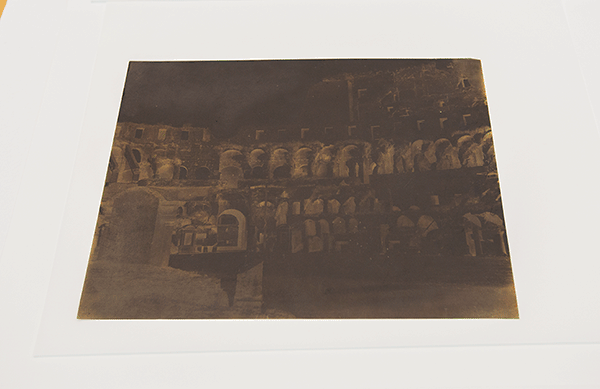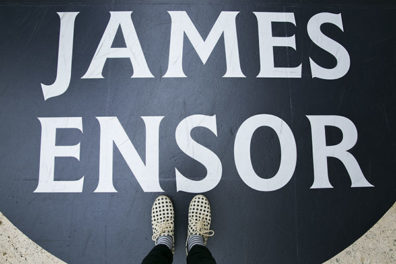
Conservator Sarah Freeman demonstrates a waxed paper negative (South porch, central portal, left jamb with Saints Matthew, Thomas, Philip, Andrew, and Peter, Chartres Cathedral, 1852, Henri Le Secq)
Today most of us expect immediate images from photography. Even children just learning to walk, who a few decades ago would not have noticed a camera pointed at them, demand to see their image on the glowing screen right after they’ve posed for the picture. We’ve stopped thinking of the photograph as the end of a fairly time-consuming process—one involving a roll of plastic-coated negative film spooled into a camera, exposed, processed in the dark, hung to dry, and cut into strips to project through an enlarger onto a larger piece of paper in the darkroom. We think less and less of the negative from which the positive prints were originally made.
Some of the earliest photographs, however, were in fact negatives. In the mid-1830s the Englishman William Henry Fox Talbot’s first trials resulted in a form of “direct negative,” what he called a “photogenic drawing.” Soon thereafter he presented his calotype negative, made by exposing a light-sensitive piece of paper in a camera, developing it in trays of chemicals, and then placing it nearly dry over another sensitized piece of paper and letting the sun reverse the tonalities once again to produce a positive print. Though he did travel to Paris to make demonstrations of the calotype, Talbot initially stalled its development both artistically and commercially by taking out a restrictive patent on his process.

Lace, before December 1845, William Henry Fox Talbot. Photogenic drawing, 6 3/4 x 8 11/16 in. The J. Paul Getty Museum, 84.XM.478.14
In 1847 the Frenchman Louis Désiré Blanquart-Evrard presented a paper negative process very similar to that of Talbot’s to a group of artists and scientists in Paris. From there, the paper negative became an art of its own in the hands of a group of French photographers including Gustave Le Gray, Édouard Baldus, Henri Le Secq, and Charles Nègre.
Exceptional examples of the paper negative process by some of these photographers were recently acquired by the Getty Museum. They are part of a group of rare salted paper prints and waxed paper negatives carefully selected from the collection of Jay McDonald, a Santa Monica resident who has actively collected photographs since the 1970s. Among the works acquired are sixteen paper negatives by Frenchmen Charles Nègre, Henri Le Secq, Louis Robert, Henri Victor Regnault, Baron Louis-Adolphe Humbert de Molard, Count Jean-François-Charles-André Flachéron, John Beasly Greene, and an additional three by British makers Captain Linnaeus Tripe, Benjamin Brecknell Turner, and Captain Horatio Ross.

South porch, central portal, left jamb with Saints Matthew, Thomas, Philip, Andrew, and Peter, Chartres Cathedral, 1852, Henri Le Secq. Waxed paper negative, 13 3/8 x 9 7/16 in. The J. Paul Getty Museum, 2015.39.1

Rooftops at Sèvres, early 1850s, Henri-Victor Regnault. Waxed paper negative, 9 5/8 x 7 1/8 in. The J. Paul Getty Museum, 2015.44

Coliseum, 1850, Count Jean-François-Charles-André Flachéron. Paper negative, 9 15/16 x 13 1/4 in. The J. Paul Getty Museum, 2015.34

Animated GIF showing the front and back of Flachéron’s negative

Tree at the Side of a Road, 1850s, John Beasly Greene. Waxed paper negative, 12 3/16 x 9 7/16 in. The J. Paul Getty Museum, 2015.36

Tarascon, 1852, Charles Nègre. Waxed paper negative with selectively applied pigment, 9 5/16 x 13 1/16 in. The J. Paul Getty Museum, 2015.43.9
For many photographers experimenting with the new medium in the 1840s and 1850s, the paper negative was the work of art. Gustave Le Gray instructed several fellow photographers in his particular waxed paper negative process, essentially a paper negative that was first waxed before being made light sensitive and placed in the camera. The wax condensed the paper fibers and created a more transparent negative, a precursor to the plastic-coated film substrate of the late 1800s. When printed, this allowed for more precise, detailed images. Where the negative was more transparent, light would pass through and create shadow areas in the positive. Where the light was obstructed by the parts of the negative exposed to more light in the camera, which caused the light-sensitive surface to darken, highlights would appear in the positive.
The paper negative could also be artfully “adjusted” to make an even stronger positive image. Many photographers used ink or gouache to touch up or cover up unwanted details, to create an even sky or sharper edges around a subject, or to add clouds that, due to exposure times, were overexposed in the original.
The myriad of applications available now to create and edit digital images is not so different from the manipulations of the paper negative in the 19th century. Still, this story reminds us that opposites are not only attracted each other, but are vital to each other, particularly in photography. In order to get a positive, until very recently you had to have a negative.




Comments on this post are now closed.